Daniel 7:13-14 “I saw in the night visions, and behold, with the clouds of heaven there came one like a son of man, and he came to the Ancient of Days and was presented before him. And to him was given dominion and glory and a kingdom, that all peoples, nations, and languages should serve him; his dominion is an everlasting dominion, which shall not pass away, and his kingdom one that shall not be destroyed.”
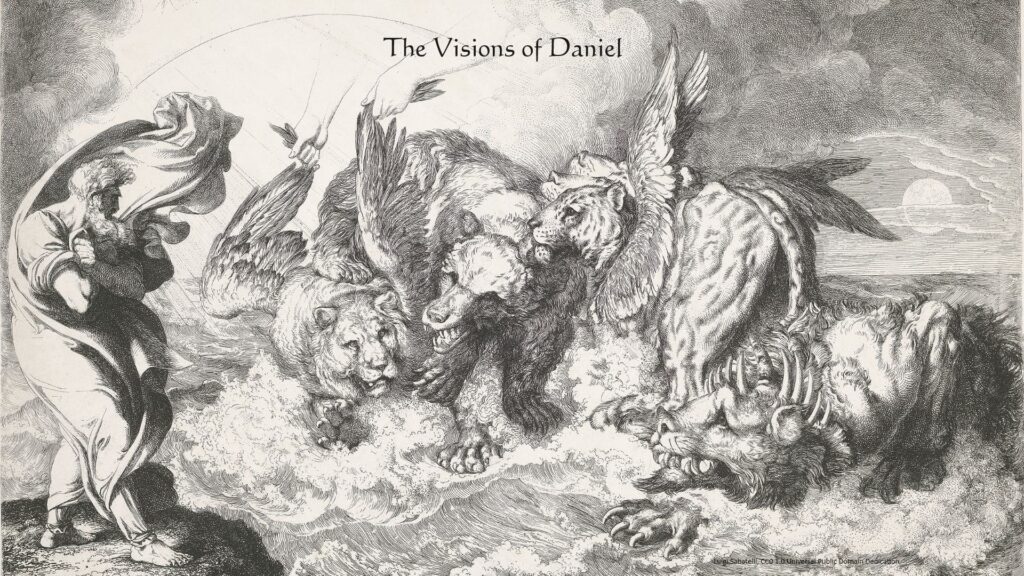
Discussion
The purpose of history, from a Jewish perspective, is to point to the culmination of all that precedes the “final” outcome of this world. The events of the past may seem random, unpredictable, even senseless or cruel. Certainly, many would say, there cannot possibly be a point or purpose that unites such disjoint events and peoples into a single purpose and outcome.
For the Jews of Daniel’s time, who were ripped from their homes and their precious promised land and transported hundreds of miles to a foreign land, and an indenture to a strange, harsh and pagan people, certainly they would be forgiven if they thought that history had come to a pointless and utterly hopeless end. But that is not what happened, and is not what they believed. Rather, as with Daniel, they began to see the broader stroke of history. History wasn’t just about the Jews, their promised land, and their relationship to God. Rather history was all about the events of this world leading, inexorably to the ultimate glory of God in Jesus Christ, and the overwhelming joy of mankind in salvation from death and suffering through faith in that same Son of God.
The Pre-flood World
You may ask: was there a pre-flood earth? As incredible as it might seem to the enlightened intelligentsia of today, there is abundant geological evidence of a world-wide cataclysm (see the section on Geology) that, as St. Peter so eloquently summed up: …the earth was formed out of water and through water by the word of God, and that by means of these the world that then existed was deluged with water and perished. (2 Peter 3:5-6)
Pause for a moment, and consider the enormity of living through and surviving a cataclysm so broad, so destructive, so frightening, so overwhelming that the very world you once inhabited no longer exists. It is simply gone. The barren new world you are suddenly thrust into bears no resemblance to the lush, comfortable and familiar world that was literally ripped out and uprooted right from under you. Everyone you ever knew beyond your immediate family is… no more. The situation is beyond comprehension. Who among us could comprehend and adapt to such a destructive transformation without simply becoming unhinged?
And yet God destroyed the world that then was in order that the world would not become so overrun with abhorrent and pervasive evil (see Genesis 6:5-13) that his only begotten Son would be unable to enter into the world to redeem his creation and save those destined to inherit the Kingdom of God (see Romans 8:12-25). It is unfortunate that the account we have of this earth shattering transformation is so often portrayed as a child’s tale with bright colors, playful animals, a funny shaped ark, and a group of happy, smiling, joyous people who are thrilled to be confined for a full year with thousands of stinking, bellowing animals constantly demanding food and water, and having perpetually to remove the refuse they generate.
Rather than painting a happy, colorful, joyful picture, if we really believed this account, it should be the stuff of nightmares. Children should not be exposed to the horrors of the flood, and young adults should wait until they are ready to grasp the enormity of the evil that pervaded and corrupted the world. Remember that God had originally created the world and universe in order to enjoy the beauty and bounty of creation with mankind as we fulfilled the Divine mandate to be the image bearers of God to care for and sustain all of creation. Our forebears utterly failed at everything.
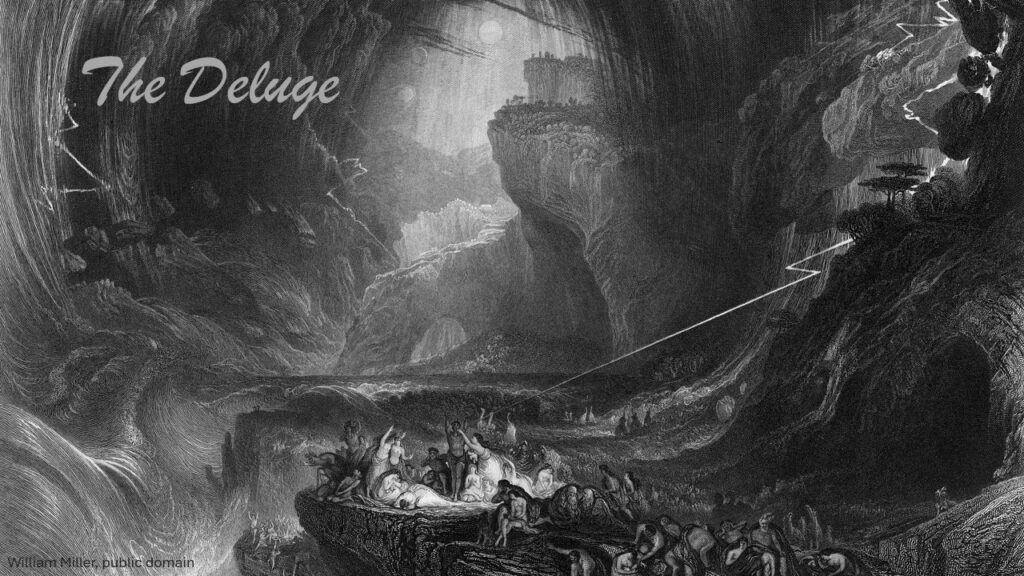
In Genesis 6:5-7 we read: The LORD saw that the wickedness of man was great in the earth, and that every intention of the thoughts of his heart was only evil continually. And the LORD regretted that he had made man on the earth, and it grieved him to his heart. So the LORD said, “I will blot out man whom I have created from the face of the land, man and animals and creeping things and birds of the heavens, for I am sorry that I have made them.”
We almost have to wonder, how is it, given the intent of God to destroy all the earth, that we are even here now? There is only one reason that we are here today. In Genesis 6:8 and 6:13-14 we read: But Noah found favor in the eyes of the Lord… And God said to Noah, “ I have determined to make an end of all flesh, for the earth is filled with violence through them. Behold, I will destroy them with the earth. Make yourself an ark…” Contemplate for just a moment how important it can be for even just one man to find favor in the sight of God.
The Post-flood World
Even for those who agree that there was a world-wide flood that destroyed all life on earth and completely reshaped the earth, there is considerable disagreement on the dates and conditions of many of the events that are recorded in Genesis chapters 10 and 11. What follows is not intended to be definitive, but it is a generally well supported exposition based on many lines of evidence for the original creation, the flood, the disposition of lands around the globe to the various people groups, the rebellion of Nimrod at Babel, and the dispersion following the confusion of tongues.
The basic timeline for the above events and others detailed in Genesis and Exodus will be based on the original work of Ussher and recent refinements to his work including the book by Dr. Floyd Nolen Jones, The Chronology of the Old Testament, and the series of articles titled, Chronological Framework of Ancient History: 1-5, published on the AIG Research Journal website by Ken Griffith and Darrell K. White. Other sources for more specific details will be cited as necessary.
Below is a Table (1) that outlines the dates for major Old Testament events.

The chart below (4, p. 27a) shows many of those dates on a simplified timeline.
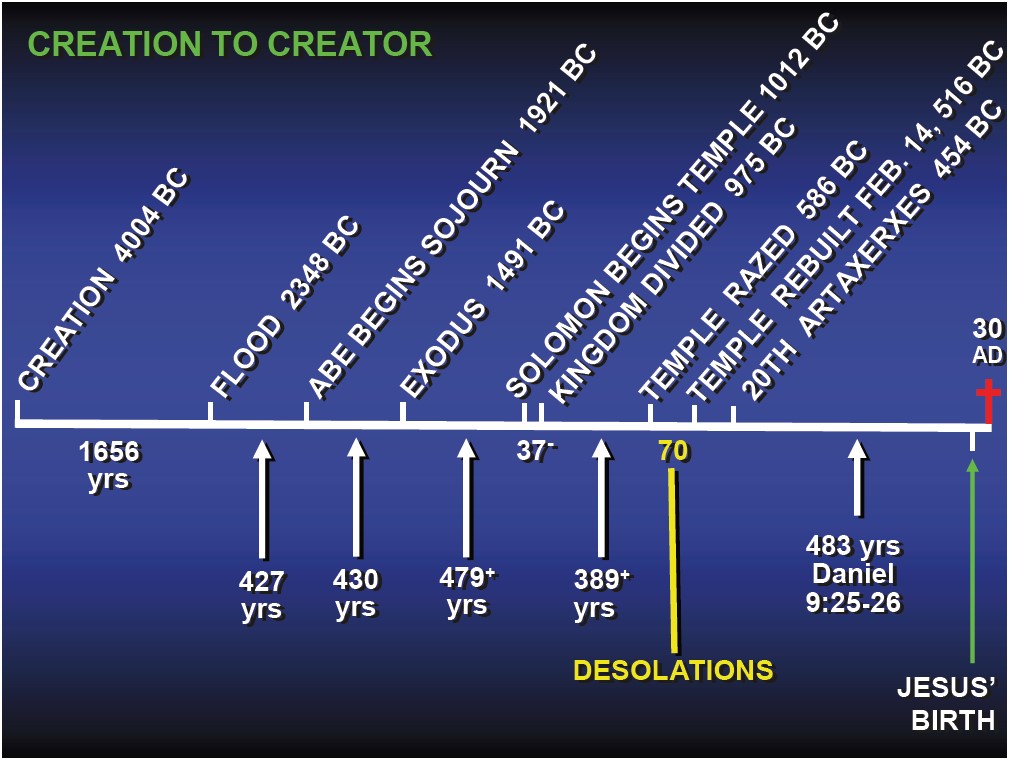
The chart below (4, p. 25a) shows the birth and death dates of the patriarchs in the line from Adam through Jacob. It is interesting to note that Noah and Shem and likely many others that survived the flood and their immediate children were very likely alive at the time Abram was born. It is also very likely that the population at the time of Abram’s birth, approximately 350 years after the flood, was between one and five million people world-wide assuming a growth rate between 3.4 and 3.9 percent, which is reasonable for a young, agrarian population (today, Syria has the world’s highest growth rate at 6.4%).
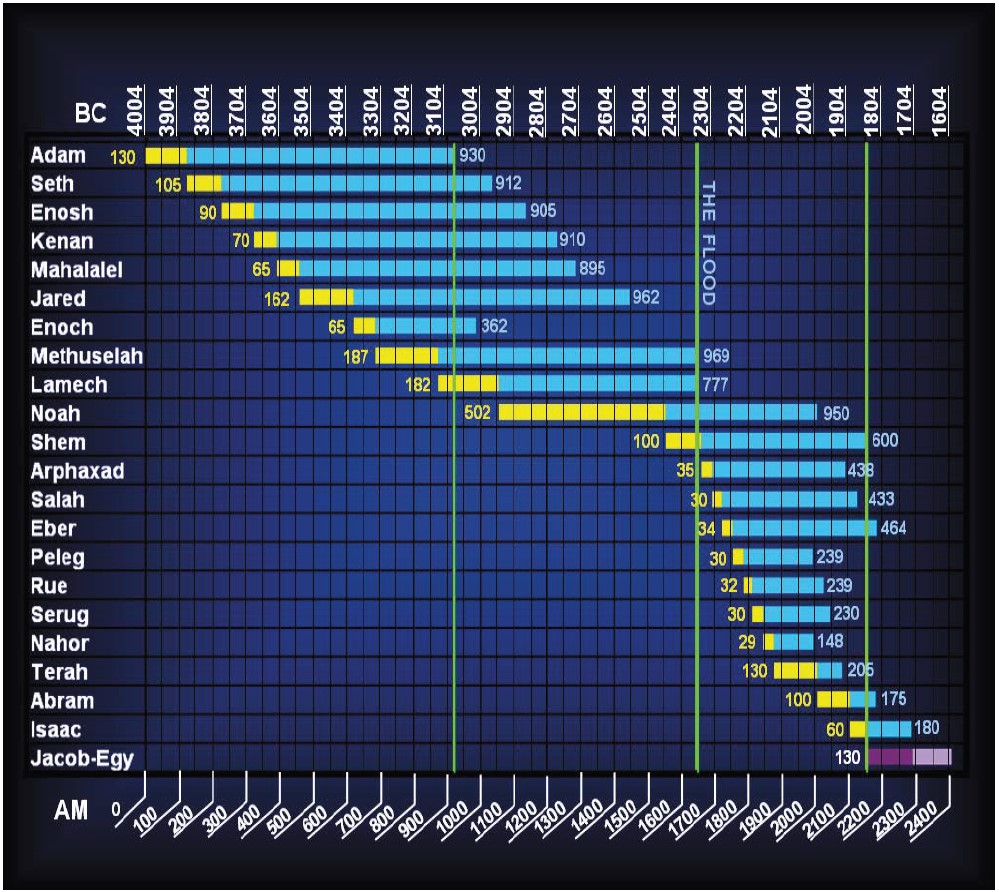
The following is a complex chart (1, Fig. 5) that uses records from many different ancient kingdoms and people groups to correlate dates for the major events described in the Bible, including creation, the flood, the disposition of land, the rebellion of Nimrod and the dispersion. You will need to refer to the referenced article to understand how the authors analyzed the various source documents and converted the various time references to our commonly used Gregorian calendar. The point of the chart is to demonstrate that most major people groups from around the globe that were dispersed after Babel, kept a record of the major events that relate to the origin events recorded in scripture. Note, in particular the various sources listed on the left. The Kali Yuga (just to the right of the source list) is an artificial “age” as defined in the Hindu religion, and does not relate to any specific Biblical event, but the dates associated with this Hindu age do correlate to the date of creation when the correct date transformation is applied (3, pp. 148-151).

The following chart is Fig. 5 of ref. (2) which depicts the duration of the Babel period with the founding of the major ancient civilizations including China, Egypt, Russia, India, the Viracocha in Peru and others. Note that this chart includes the birth of Terah and Abram. The date for “Peleg Earth Divided 2747” is a typo in the original article, and should be 2247 being 101 years after the flood. The “Peleg Earth Divided” represents the allotment that Noah authorized for the various people groups to disperse and fill the earth (Gen. 9:1 and 10:25).

Regarding the division of the lands, there is an interesting possibility that a map known as the Piri Reis, (see below) created in 1513 AD, includes a representation of the continent of Antarctica without its overburden of ice. This possibility is very controversial (5, 6), and its inclusion here should not be construed as support for it being a representation of Antarctica. Nonetheless, in order to “divide” the earth appropriately after the flood and direct the dispersion of the peoples, there would have been a survey of the globe. It is certainly possible that vestiges of this first exploration of the new world may have found its way over the centuries to the cartographer who drew this intricate map.
Given that life would be a challenge after the flood, it is understandable that a thorough survey of the world could easily have required the one hundred years recorded between the flood and when the earth was divided in the day of Peleg or, perhaps better to say, apportioned among the people. By then, at that time, there would have been only several hundred people alive and certainly no more than three thousand which would require a growth rate of six percent. With the prospect of dividing the people into smaller and possibly vulnerable groups, and then scattering them abroad into a potentially hostile and harsh world, it is not too much of stretch to see Nimrod convincing the people to: “Come, let us build ourselves a city and a tower with its top in the heavens, and let us make a name for ourselves, lest we be dispersed over the face of the whole earth.” (Gen. 11:4)
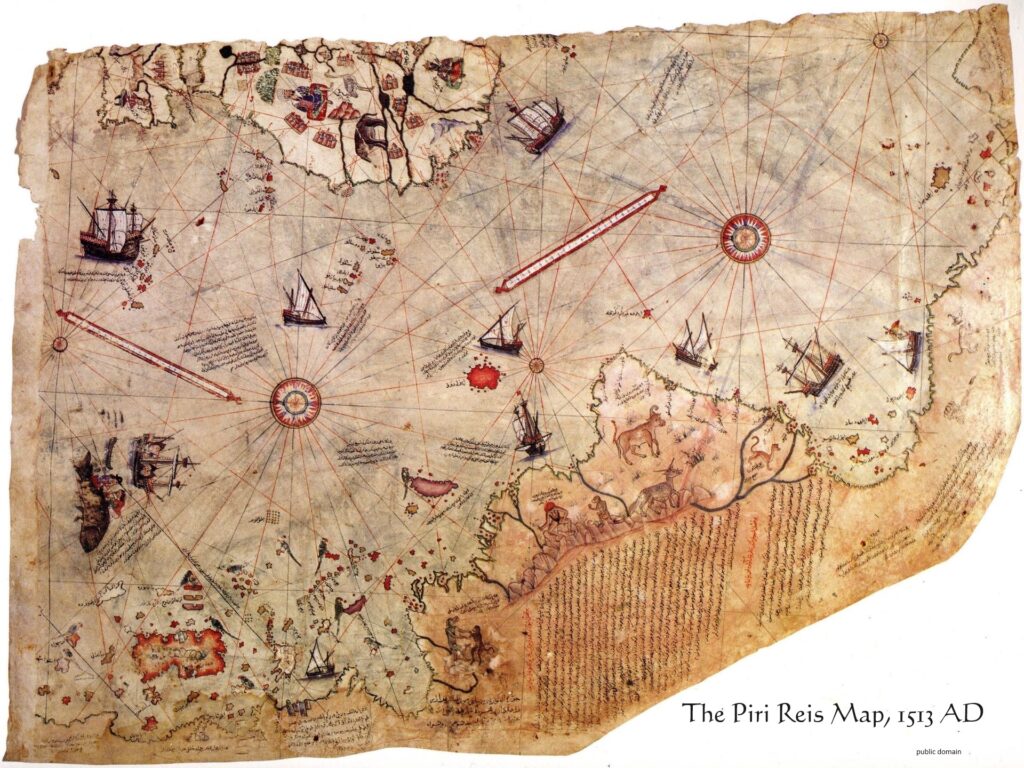
Nimrod rebels
The rebellion of Nimrod is closely associated with a mysterious woman with uncertain origins and an extensive legacy in the ancient pantheon of pagan religions. Nimrod, who has been identified with the ancient Sumerian ruler Enmerkar, claimed to have ‘brought Inanna down from the mountains,’ to make ‘An’ (or Anu), i.e. the ‘God of Heaven,’ his female consort, and thus introduced the fertility rites into the early post-Flood world. The article, “The Ark Landing, the Migration, and the Early Settling of Noah’s Sons. Part 1,” from the Answers Research Journal, goes on to say:
So, it appears, began the ritual of the priestess representing the god and the beginning of temple prostitution under the concept of a “holy marriage.” This clearly is one of the historic events Paul referred to in Romans 1:21–23: “When they knew God, they glorified Him not as God, neither were thankful; but became vain in their imaginations and their foolish heart was darkened. Professing themselves to be wise, they became fools, and changed the glory of the uncorruptible God into an image made like corruptible man . . .” (KJV).
In fact, it appears that this act became identified with Enmerkar (Nimrod) and his wife/sister, for he is later referred to as Bel (the Babylonian form of Baal—later identified as Marduk) and Innana as the Semitic Ishtar, biblically called Ashtaroth, the consort of Baal. This myth spread across the known world after the dispersion so that Enmerkar, and perhaps to some extent Cush also, became involved in introducing the first idolatry after the Flood. Inanna is known later in Assyria and Babylonia as Ishtar (Semitic form), Astarte by the Syrians, Ashtaroth to Israel, Isis to the Egyptians, Durga to the Dravidians, and Aphrodite to the Greeks. And so the idolatrous cult spread around the world at the dispersion as a result of Nimrod’s actions. (7, p. 522)
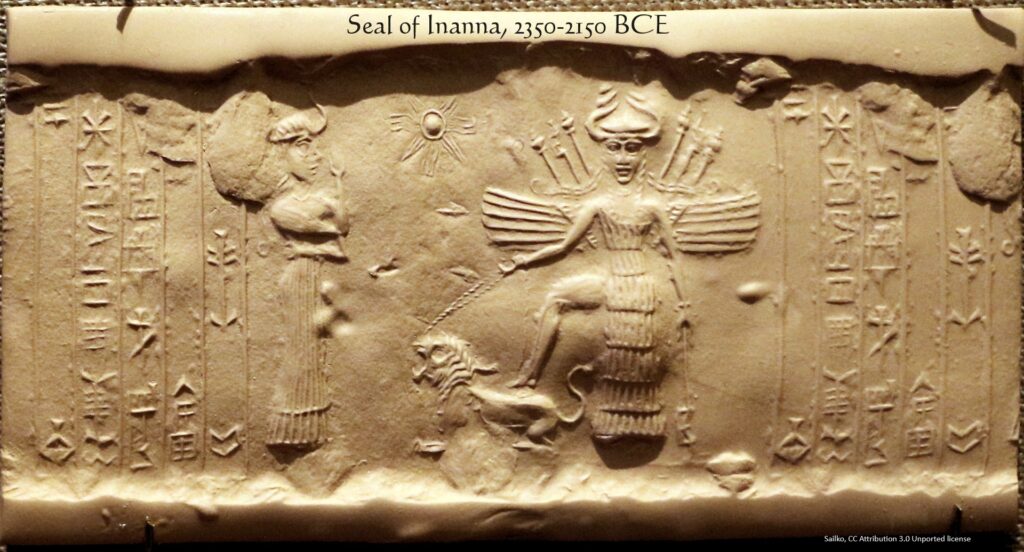
- Ancient Akkadian cylinder seal depicting the goddess Inanna resting her foot on the back of a lion while Ninshubur stands in front of her paying obeisance, c. 2350–2150 BCE (Note: dating is conventional rather than Ussher timeline)
We might also add, “and as a result of Inanna’s actions as well.” Who was Inanna? This woman who was largely responsible for the demise of the rightful worship of God within a century after the flood. There are other sources which have more to say regarding this female demigod. Quoting from the book, Genesis Characters and Events in Ancient Greek Art:
The ancient poet Homer referred to Artemis as the “Mistress of Wild Animals.” This makes no sense unless we connect her to Naamah/Nammu, wife of Ham, on board the ark with all those wild animals for nearly a year. Most of mankind gave her credit, not Noah, for bringing the animals through the Flood.
Most of the significant ancient goddesses were linked to the Flood in some way, beginning with the one whom they represented, Naamah/Nammu. Baring and Cashford: “The images of water and sea, the unfathomable abyss of the Deep, return us to Nammu, the Sumerian goddess whose ideogram was the sea . . .” Baring and Cashford again: “Asherah [a Canaanite goddess] was called ‘the Lady of the Sea,’ which links her to the Sumerian Nammu, and to the Egyptian Isis, ‘born in all wetness.’” Those descriptions of the great Cainite woman who became worshipped as a goddess evoke the memory of the Flood.
According to Baring and Cashford, in both the Babylonian and Sumerian stories, Inanna and Ishtar, derivative goddesses of Naamah/Nammu, lament the destruction of their people in the Flood. In the Epic of Gilgamesh, the earliest surviving work of historical literature, Ishtar prepares a post-Flood offering similar to the one Noah prepared for Yahweh in Genesis 8:20. There is one huge difference: Ishtar says, “Let all the gods gather round the sacrifice, except Enlil [Baring and Cashford identify Enlil as Yahweh, or Jehovah]. He shall not approach this offering, for without reflection he brought the Flood; he consigned my people to destruction.” Ishtar is Naamah. Her “people” are the people of the line of Cain left behind to drown in the Flood. (8, Loc. 409)
We will shortly delve deeper into the history of the woman Inanna, who appears to have had multiple identities in the ancient world, and was perhaps and apparently the wife of Ham, which would have made her one of the survivors from the pre-diluvial world. And who does she refer to as her “people,” when, speaking as Ishtar, she says: “he (i.e. God) consigned my people to destruction”? But first we will delve into one final very unusual “lifestyle” arrangement of the woman Inanna. Quoting from the article, “Chronological Framework of Ancient History. Part 3”:
Strange as it sounds, we suspect that the woman Semiramis [i.e. Inanna (3, p. 147)], after the death of Ninus/Nimrod, dressed as a man and took the throne as Dumuzi in Uruk and Uadji/Uonephes in Egypt, both of which were male names. Six months of the year she dressed as a man and sat on the throne, as Justin described, and for six months she dressed as herself. Thus in Egypt there are two tombs, one for the man Uadji, and one for his wife Merneith. But, as Justin related, this was merely a ruse to allow her to hold a man’s office.
This bizarre practice became tradition followed by later women who became rulers of Egypt. The next six female pharaohs, including Hatshepsut and Cleopatra, all dressed as men and wore a fake beard while sitting on the throne. (3, pp. 147-148)
If these accounts from very ancient records are accurate, then Inanna was a very resourceful and powerful woman of the ancient world. Oddly enough there was apparently an interesting reference to this Egyptian queen Merneith in a Fox News article title: Egyptian queen tomb discovery… from 5,000 years ago. The subtitle was: Queen was possibly the first female pharaoh of Ancient Egypt. Quoting from the article:
The find, one of the oldest ever, was among the “grave goods” for Queen Meret-Neith in Abydos, from 3,000 BC, according to SWNS, the British news service. The University of Vienna researchers say she was the most powerful woman in the period and possibly the first female pharaoh of Ancient Egypt. Queen Meret-Neith was the only woman to have her own monumental tomb in Egypt’s first royal cemetery at Abydos.
Meret-Neith’s monumental tomb complex in the Abydos desert, which includes the tombs of 41 courtiers and servants in addition to her own burial chamber, was built of unbaked mud bricks, clay and wood. Inscriptions indicate that Queen Meret-Neith was responsible for central government offices such as the treasury, which supports the idea of her special historical significance, the scientists revealed. She added, “The new excavations bring to light exciting new information about this unique woman and her time.” The archeological team found evidence of a huge amount of “grave goods,” including hundreds of large wine jars. Thanks to careful excavation methods and new archaeological technologies, the team was able to show that the tombs were built in several construction phases and over a relatively long period of time… (9)
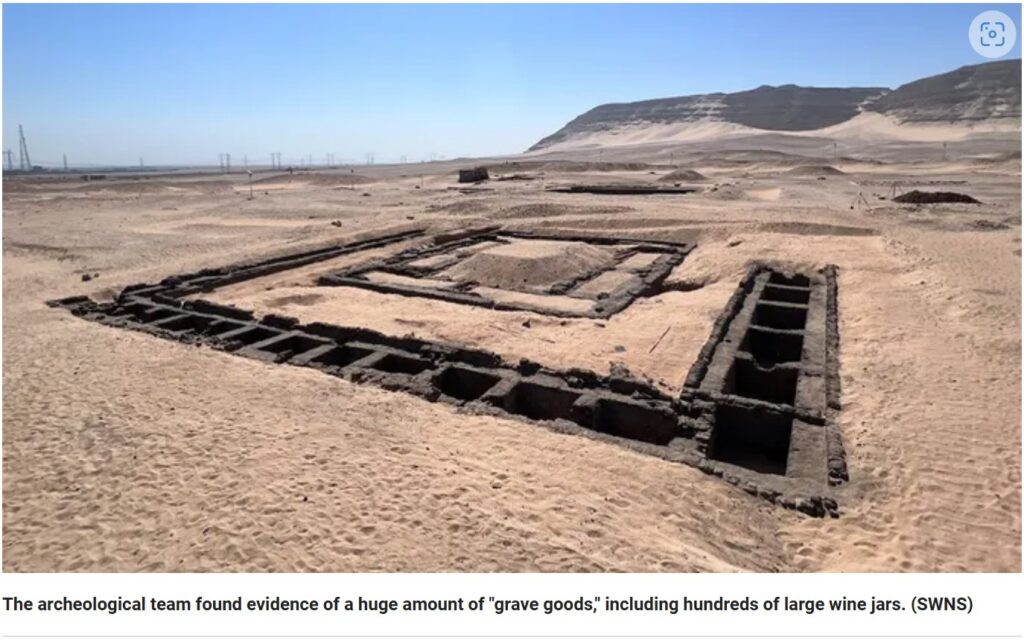
Note how similar the names are for Queen Meret-Neith, as given in the Fox News article, and that of Queen Merneith as used in the article of reference 3. Also note the similarity in the description of the honor and power of the two women, as well as both being the first Queen (i.e. Pharaoh) of Egypt. Even the dates when she lived are similar, especially since secular dates are generally older than the Biblical timeline dates. Almost certainly these references are to the same person and attest to the uniqueness of the woman Inanna in the ancient pantheon of those who survived the world-wide flood and re-populated the world. But we are still left with the question, who was this woman who apparently rode the oceans as a member of the immediate family of Noah by marriage?
Remember earlier, when quoting from reference 8, we noted that Ishtar, one of the names of Inanna, is also Naamah. In Genesis 4:17-22 the descendants of Cain are listed, and verse 22 reads: Zillah also bore Tubal-cain;… The sister of Tubal-cain was Naamah. Nothing more is said of Naamah, but there are several interesting aspects of this reference. First, it comes just before the descendants of Seth are listed in chapter 5, which included Noah of course, and the account of the world-wide flood in chapters 6, 7 and 8. Naamah is also the only female descendant of Adam and Eve who is named in the pre-flood world, indicating that she was apparently singled out for some unspecified, but nonetheless, important reason.
Could this woman, Naamah, have been the reason that pagan worship and mythological practices gripped the people of the new world so soon after the flood? Looking back in history, it is obvious that paganism dominated most belief systems despite the presence of Noah, Shem, Japheth and others who remained faithful to the true God, and who were most likely still alive when Abram was born. Food for thought…
The Dispersion
The rebellion of Nimrod and the rise of paganism and mythology led God to confusing the language of the people and dispersing them around the globe. As we read in Genesis 11:8-9: So the LORD dispersed them from there over the face of all the earth, and they left off building the city. Therefore its name was called Babel, because there the LORD confused the language of all the earth. And from there the LORD dispersed them over the face of all the earth.
The dispersion, permanent separation and isolation of various people groups generated genetic “bottlenecks” with a subsequent reduction of allele variation in different groups that resulted in the various genetic strains that today we call “races.” However, as the modern world has generated a vast “melting” pot of these various genetic strains, we are discovering that we are truly “one” people rather than separate “races,” which is a false distinction promoted in large part in the west by Darwinian evolution and the discredited concept of eugenics (11).
The dispersion of people around the globe happened relatively quickly as people groups fled from the area of Babel after the confusion and discord of everyone speaking different languages. Some groups were better prepared than others for nation building and “civilization,” while some number of people groups descended into a more primitive level of existence that we generally label as “stone age” due to their reliance on stone tools for subsistence in a hunter/gatherer society.
During this same time an Ice Age was developing quickly due to a combination of very warm oceans that were heated by the global geological processes during the flood (see the section on Geology), and a cool environment due to multiple volcanic eruptions around the globe, also due to the flood (12). These conditions persisted for a few hundred years until the oceans cooled and volcanic eruptions diminished. The large amount of water trapped in continental-wide glaciers resulted in lowered ocean levels that opened land bridges between several continents, and generated a moist, almost tropical environment near many coastal areas far into the arctic regions due primarily to the warm oceans. The combination of land bridges and abundant fauna in far northern climes, allowed many people groups to migrate quickly to all the continents except Antarctica. Also, the intelligence and practical ability of many people groups enabled the eventual population of numerous islands particularly in the south pacific.
Pre-human hominids?
You might wonder what evidence there is for humans in pre-history, especially humans in what should be “ancient” sediments where pre-human hominids are thought to be the sole “residents.” Surprisingly, some of the best evidence of humans in otherwise ancient settings comes from the famous Olduvai Gorge, where the well-known Leakey family supposedly discovered our pre-human cousins. Quoting from the book, Contested Bones (13):
…Reck found the first human bones from Olduvai Gorge (OH 1), nicknamed “Oldoway Man.” The skeleton was nearly complete and unquestionably modern in its anatomy. It was excavated from Bed II making it the oldest discovery of a modern Homo sapiens. Reck reported his find, and invited Louis Leakey to visit the Olduvai site. At first, Leakey was skeptical about Reck’s find, until 1931 when he collaborated with him in Tanzania and examined the finding firsthand. Leakey was then convinced that Oldoway Man was authentic. But this was an unwelcome find for most paleoanthropologists who did not accept the possibility of such an early date for the origin of man (1.15–1.7 million years old, according to current potassium-argon dates for Bed II). This is significantly older than the oldest currently accepted Homo sapiens fossil; a jawbone that dates 315,000 years old was recently found in Jebel Irhoud, Morocco of northern Africa. (13, p. 411)
Those who had actually seen and carefully analyzed the site first-hand made numerous observations demonstrating that Oldoway Man could not have been an intrusive burial. Reck, who understood the geology at Olduvai better than anyone noted, “The bed in which the human remains were found … showed no signs of disturbance. The spot appeared exactly like any other in the horizon. There was no evidence of any refilled hole or grave.” (13, pp. 411-412)
Although there was no valid evidence against its authenticity, scientific politics won the day. Louis Leakey eventually yielded to the demands of the senior members of the paleo-community to dismiss the finding, as those hostile to his position were reviewing his latest submitted papers. Since then, Oldoway Man has been largely forgotten. If mentioned at all, Oldoway Man is listed as an “intrusive burial.”48 But the early debate about Oldoway Man is well documented in a series of Science papers.49 This is just one more example of fiercely contested bones and the unceasing effort to force the data to conform to the ape-to-man narrative. (13, pp. 412-413)
During the same year of her publication in Nature, Mary made another remarkable discovery that further confirmed the presence of humans at the Laetoli site. A heel impression of a “hominin” foot was fossilized in ash just a short distance from where one of her Homo specimens (LH-5 upper jawbone) was found.51 Excavations continued over the next two field seasons to reveal an entire bipedal footprint trail (labeled site G). A total of nearly 70 footprints were uncovered, with the trail continuing for 88 feet. The Laetoli G footprints appear to have been made by three individuals (one of whom was smaller, walking in the footprints of another) traveling in the same direction in close proximity. The fossilized footprints were dated as being 3.7 million years old, the same age as the Homo bones. The findings were published in Nature in 1979. (13, pp. 413-414)
We have already discussed in chapter 7 the observations from a number of paleoexperts who acknowledged what is already self-evident to any casual observer: the morphology of the Laetoli footprints is unmistakably human. Mary, Tim White, Owen Lovejoy, Russell Tuttle, among others, describe them as looking “indistinguishable from those of habitually barefoot Homo sapiens.” (see chapter 7). Yet their radioisotopic age approaches 4 million years old! According to the standard ape-to-man story, that should be utterly impossible. How can upright-walking anatomically modern humans exist at the time of Lucy, well over a million years before the first humans (Erectus) are said to have evolved? (13, p. 414)
The Laetoli footprints would have resulted in a comprehensive re-examination of the ape-to-man story, if it had not been for Donald Johanson and Tim White. They subsequently reclassified all of Mary Leakey’s Homo fossils, assigning them to Johanson’s reputed new species Australopithecus afarensis (Lucy’s kind) from Hadar, Ethiopia. The human-looking footprints were also credited to Afarensis. This is extraordinary because no australopith skeleton has ever been found clearly associated with anatomically modern human feet… This single event (assigning the Laetoli Homo bones and the Laetoli footprints to Lucy’s kind) is remarkable in that it reflects a major turning point in the field of paleoanthropology. It also reflects what looks to be an unprecedented example of showmanship, manipulation, and scientific politics. (13, pp. 414-415)
You be the judge. Who would you believe?
References
(1) Griffith, K. C. , & White, D. K. (2022). Chronological Framework of Ancient History. 1: Problem, Data, and Methodology. Answers Research Journal, 15, 377–390. https://answersresearchjournal.org/ancient-egypt/chronological-framework-ancient-history-1/.
(2) Griffith, K. C. , & White, D. K. (2022). Chronological Framework of Ancient History. 2: Founding of the Nations. Answers Research Journal, 15, 405–426. https://answersresearchjournal.org/tower-of-babel/chronological-framework-ancient-history-2/.
(3) Griffith, K. C. , & White, D. K. (2023). Chronological Framework of Ancient History. 3: Anchor Points of Ancient History. Answers Research Journal, 16, 131–154. https://answersresearchjournal.org/ancient-egypt/chronological-framework-ancient-history-3/.
(4) Jones, F. N. (1993). Chronology of the Old Testament: A Return to the Basics. Master Books.
(5) https://en.wikipedia.org/wiki/Piri_Reis_map
(6) https://allthatsinteresting.com/piri-reis-map
(7) Osgood, A. (2023). The Ark Landing, the Migration, and the Early Settling of Noah’s Sons. Part 1: The Beginning and the Sons of Shem. Answers Research Journal, 16, 501–528.https://answersresearchjournal.org/archaeology/ark-landing-migration-early-settling-noahs-sons-part-1/.
(8) Johnson Jr, Robert Bowie. Genesis Characters and Events in Ancient Greek Art . Solving Light Books. Kindle Edition.
(9) Fox News Lifestyle, 10/15/2023 accessed 8/9/2024
(11) Adam, Eve and Noah vs Modern Genetics
(12) The unique post-Flood Ice Age
(13) Rupe, Christopher; Sanford, Dr. John. Contested Bones (p. 411). FMS Publications. Kindle Edition.